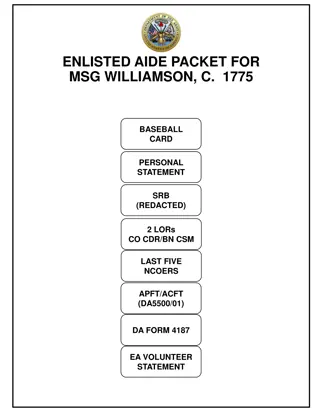
Analysis of Economic Organization Forms
This article delves into the comparative study of market, hybrid, and hierarchy forms of economic organization. It discusses coordinating mechanisms, adaptive abilities, and contract law influences. The aim is to refine Transaction Cost Economics (TCE) by addressing criticisms and exploring discrete structural alternatives. Factors like institutional development, contract law, and means of governance are emphasized for comprehensive analysis.
Download Presentation

Please find below an Image/Link to download the presentation.
The content on the website is provided AS IS for your information and personal use only. It may not be sold, licensed, or shared on other websites without obtaining consent from the author. Download presentation by click this link. If you encounter any issues during the download, it is possible that the publisher has removed the file from their server.
E N D
Presentation Transcript
Comparative Economic Organization: The Analysis of Discrete Structural Alternatives Oliver E. Williamson, 1991 Administrative Science Quarterly Daniela Pedraza Novak Spring 2021
Overview o Distinguished three generic forms of economic organization: market, hybrid, and hierarchy. Different coordinating and control mechanisms Different abilities to adapt to disturbances Supported by a distinct type of contract law o Identified parameters that cause shifts in the comparative costs of governance
Motivation To extend and refine TCE by responding to some of the leading criticisms The institutional environment and the institutions of governance have developed in disjunct ways. TCE neglects intermediate or hybrid forms by dealing with polar forms markets and hierarchies. Dimensionalization of transactions and governance is needed. The embeddedness problem TCE has been developed almost entirely with reference to Western capitalist economies.
Discrete Structural Analysis Simon (1978) Discrete structural alternatives are compared A much more qualitative institutional analysis than we are used to with TCE. Factors that support its use: 1. Firms are not merely extensions of markets but employ different means. 2. Discrete contract law differences support and define each generic form of governance. 3. Marginal analysis is typically concerned with second-order refinements to the neglect of first-order economizing.
1. Different Means Each viable form of governance - market, hybrid, and hierarchy - is defined by a syndrome of attributes that bear a supporting relation to one another. Many hypothetical forms of organization never arise, or quickly die out, because they combine inconsistent features. Hierarchy is not merely a contractual act but is also a contractual instrument, a continuation of market relations by other means. The challenge to comparative contractual analysis is to discern and explicate the different means.
2. Contract Law Each generic form of governance - market, hybrid, and hierarchy - needs to be supported by a different form of contract law. Classical contract law supports the autonomous market. Neoclassical contract law supports hybrid modes. Applies to contracts in which the parties to the transaction maintain autonomy but are bilaterally dependent to a nontrivial degree. Applies to consequential disturbances as it (1) contemplates unanticipated disturbances, (2) provides a tolerance zone (3) requires information disclosure and substantiation if adaptation is proposed, and (4) provides for arbitration in the event voluntary agreement fails.
2. Contract Law (continued) Forbearance law supports hierarchy. As disturbances become highly consequential, neoclassical contracts incur added costs and experience real strain. Hierarchy is its own court of ultimate appeal Disputes can be addressed internally, in a more adaptive, sequential, and cooperative manner. The underpinning rationale for forbearance law is twofold: 1. Parties to an internal dispute have deep knowledge of dispute and efficient solutions. 2. Permitting internal disputes to be appealed to the court would undermine the efficacy and integrity of hierarchy.
3. First Order Economizing Defined as effective adaptation and elimination of waste. Neoclassical economics was too preoccupied with issues of allocative efficiency to the neglect of organizational (form) efficiency. Marginal Analysis (second order refinements) Discrete Structure Analysis (first order economizing)
Dimensionalizing Governance Key differences among governance structures: Contract law Adaptability The central problem of economic organization Adaptation A (Autonomy): Neoclassical ideal in which consumers and producers respond independently to price changes. Adaptation C (Cooperation): Conscious, deliberate, and purposeful efforts of adaptive internal coordination. Incentive/Control instruments Incentive intensity (market) vs Administrative controls (Hierarchy)
Dimensionalizing Governance Markets and hierarchies are polar modes. How do hybrids compare with respect to adaptability (type A and C), incentive intensity, and administrative control?
The Hybrid Mode Characterized by: o Semi-strong incentives o Intermediate degree of administrative apparatus o Semi-strong adaptations of both kinds o Semi-legalistic contract law regime Different from both the classical contract law of markets and the forbearance contract law of hierarchies. More elastic than the former and more legalistic than the latter.
Discriminating Alignment Transactions (which differ in their content) are aligned with governance structures (which differ in their costs and competencies) in a discriminating way mainly transaction cost economizing way. o Critical dimensions with respect to which transaction differ Frequency Uncertainty Asset Specificity The degree to which an asset can be redeployed to alternative uses and by alternative users without sacrifice of productive value. Creates bilateral dependency and poses added contractual hazards. Increases the transaction costs of all forms of governance.
Reduced-Form Analysis M(0)<X(0)<H(0) M >X >H >0 U-form Much control M-form Little control Hybrid Hierarchy Market
Parameter changes and comparative costs of governance The institutional environment (seen as a set of parameters) is the set of fundamental political, social and legal ground rules that establishes the basis for production, exchange and distribution. 4 types of parameter changes can induce a shift from market, to hybrid, to hierarchy (or the reverse) 1. Property rights Government expropriation or leakage ( rivals, suppliers, customers). 2. Contract law 3. Reputation effects 4. Uncertainty More disturbances occur or disturbances become more consequential. Most Susceptible
Conclusion (I) The economic problem of society is adaptation (autonomous and coordinated). (II) Each generic form of governance is shown to rest on a distinctive form of contract law (classical, neoclassical, forbearance). (III) The hybrid form of organization possesses its own disciplined rationale. (IV) The logic of each generic form of governance - market, hybrid, and hierarchy is revealed by the dimensionalization and explication of governance. (V) The institutional environment and the institutions of governance are joined by interpreting the institutional environment as a locus of shift parameters, changes in which parameters induce shifts in the comparative costs of governance.
Discussion oA limitation of the discrete structural approach employed in this article is that parameter changes (not increases or decreases but rather improvements or the lack thereof) need to be concentrated disproportionally on one generic mode of governance to have an effect (to elicit a shift in governance form). o Equilibrium vs Temporary forms of organization Timing and quick responsiveness can be crucial (innovation) The apparatus developed here should not be applied uncritically. o Williamson examines parameter changes of four kinds (property rights, contract law, reputation effects, and uncertainty). Can you think of any other important kinds that are not included?






















